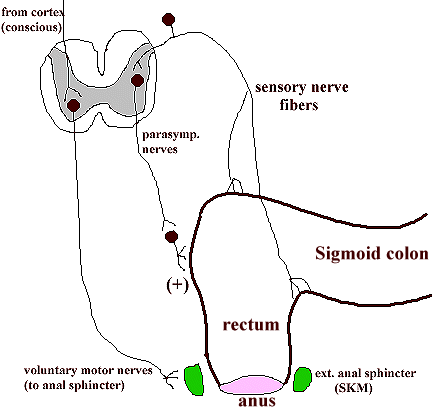Q. Describe about defecation reflex?
An example of a reflex having an autonomic (and somatic) component is the DEFECATION REFLEX:
The rectum is generally empty, but when feces are forced into it by mass movements, stretching of the rectal walls initiates the defecation reflex. This involves mainly the sacral region of the spine, and causes the smooth muscles around the sigmoid colon and rectum to contract, while the anal sphincter is relaxed.
- Walls of sigmoid colon/rectum distend -> sensory nerves send signals to spine -> parasympathetic nerves cause contraction of smooth muscles in rectal region -> propels feces for excretion
Note however that simultaneously cerebral control from cortex is possible, i.e. messages reaching the brain allow us to decide whether the external sphincter (skeletal muscle tissue) will remain open for defecation.
If the decision is to delay, then reflex contractions are ended (and rectum relaxes until next wave of distention).

Note: we ordinarily aid defecation by closing the glottis (to keep air in lungs) and contracting the diaphragm (and abdominal muscles) to increase the abdominal pressure. This is called the Valsalva maneuver (which helps forcing feces distally).
Incontinence (normal in infants) occurs as no control has been acquired yet of the ext. anal sphincter, may also occur from spinal cord transections.